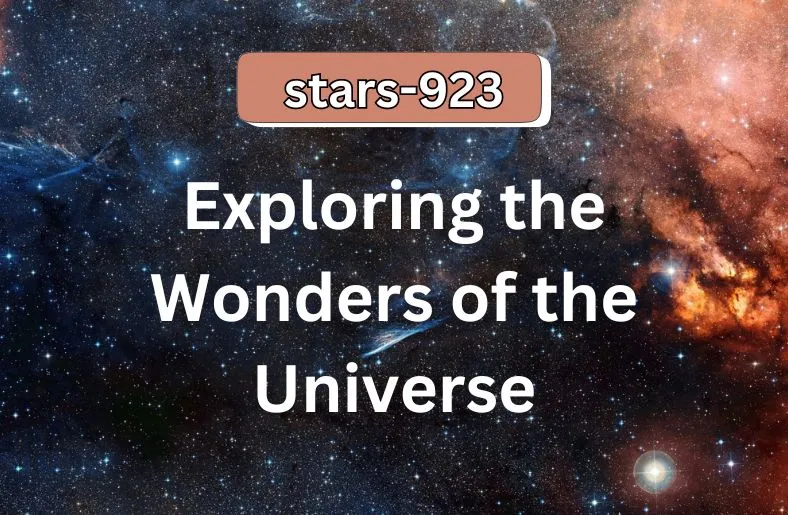Introduction
Stars have always intrigued people, lighting up the night sky with their beauty and mystery. They are more than just points of light; they are massive celestial objects with complex life cycles. Among these stars, “Stars-923” stands out as an especially captivating subject. It offers a fascinating glimpse into the life and evolution of stars.
This blog post will take you on a journey through the life of Stars-923. We will explore its formation, its stable life as a main-sequence star, and its transformation into a red giant. We will also discuss what happens when it dies and how scientists observe it.
By the end of this post, you will have a deeper understanding of Stars-923. You will learn not only about its scientific aspects but also about its cultural significance and the future research that will continue to shed light on its mysteries.
1. The Birth of Stars-923
Formation in Molecular Clouds
Stars like Stars-923 begin their life in massive clouds of gas and dust known as molecular clouds. These clouds are the star-forming regions of space. Over time, gravity pulls the gas and dust together, creating dense cores. As these cores become more compact, the pressure and temperature inside them rise.
Eventually, the conditions in these cores become extreme enough to trigger nuclear fusion. This process marks the birth of a new star. For Stars-923, this means transitioning from a cloud of gas and dust into a glowing star. Gravity’s role in pulling materials together is crucial to this transformation.
Ignition of Nuclear Fusion
When the core of Stars-923 reaches a high enough temperature, nuclear fusion begins. In this process, hydrogen atoms fuse to form helium, releasing a tremendous amount of energy. This energy is what causes Stars-923 to shine brightly.
The balance between the gravitational pull inward and the energy from fusion pushing outward keeps the star stable. This phase, where Stars-923 becomes a main-sequence star, is a key period in its life. It will spend most of its life in this stable state, shining steadily as it continues to fuse hydrogen into helium.
2. The Main Sequence Phase of Stars-923
Characteristics of Main Sequence Stars
During the main sequence phase, Stars-923 exhibits several key characteristics. It burns hydrogen in its core, producing a steady amount of energy. This energy creates a balance between gravity, which pulls the star’s material inward, and radiation pressure, which pushes outward.
This balance is what makes Stars-923 stable and keeps it from collapsing or expanding uncontrollably. Main sequence stars like Stars-923 are the most common type of star and are characterized by their consistent brightness and long lifespan. They are the backbone of their respective galaxies.
Unique Features of Stars-923
it has unique features that set it apart from other main sequence stars. While it shares common traits such as steady energy production and stability, it may differ in size, brightness, and color. These differences arise from its specific mass and composition.
The unique luminosity and color of it make it interesting to astronomers. By studying these features, scientists can learn more about how different stars behave and how they evolve over time. Understanding these unique characteristics helps in the broader study of stellar astrophysics.
3. Transition to the Red Giant Phase
Changes in Stars-923
As Stars-923 exhausts its hydrogen fuel, it begins a dramatic transformation. The core contracts under gravity, while the outer layers expand. This process causes the star to cool and turn red, making it a red giant.
During this phase, it starts to fuse heavier elements such as helium. This transition is a significant shift in the star’s life cycle. The star’s size increases, and its outer layers become cooler, giving it a reddish hue. These changes mark the beginning of the final stages of Stars-923’s life.
Visual and Physical Changes
Astronomers observe several notable changes in Stars-923 during the red giant phase. The star’s outer layers expand and cool, resulting in a red appearance. This phase is marked by increased luminosity due to the larger size.
The star’s physical appearance and brightness provide important clues about its evolution. By studying these visual changes, scientists can gain insights into the life cycle of it and how it compares to other stars in similar stages. These observations are crucial for understanding stellar evolution.
4. The Death of Stars-923
Possible End Stages
The death of Stars-923 depends on its mass. Smaller stars typically end their lives as white dwarfs. They shed their outer layers, leaving behind a dense, cooling core.
Larger stars may undergo a supernova explosion, which can result in a neutron star or even a black hole. These end stages are defined by dramatic events and produce different remnants. The fate of Stars-923 will determine the nature of its final stages and its impact on its surroundings.
Impacts on the Surrounding Space
The death of Stars-923 has significant effects on nearby space. A supernova explosion disperses heavy elements into the interstellar medium, contributing to the formation of new stars and planets.
If it becomes a white dwarf, its impact is less dramatic but still important. Neutron stars and black holes can influence nearby celestial objects due to their intense gravity. The star’s death thus plays a role in shaping the galaxy and affecting other cosmic structures.
5. Observing Stars-923
Tools and Techniques
To study Stars-923, astronomers use various tools and techniques. Telescopes capture light from the star, allowing scientists to observe its properties. Instruments like spectrographs analyze the light to determine the star’s composition, temperature, and movement.
Space telescopes, such as the Hubble Space Telescope, provide clearer images by avoiding Earth’s atmosphere. These advanced tools are essential for detailed observations and understanding the star’s characteristics. They help scientists gain insights into Stars-923 and its role in the universe.
Recent Discoveries
Recent research has revealed new details about Stars-923. Scientists have discovered more about its composition, behavior, and role in the galaxy. Advances in observational techniques have led to more precise measurements and a better understanding of the star.
These discoveries contribute to our knowledge of stellar evolution and the broader cosmic environment. By keeping up with the latest research, we can continue to learn more about it and its significance in the universe.
6. The Role of Stars-923 in the Galaxy
Contributions to Galactic Dynamics
Stars-923 plays a vital role in the galaxy. Its formation and evolution contribute to the galaxy’s overall structure. By participating in the formation of planetary systems, it helps shape the galaxy’s environment.
Stars-923’s interactions with other stars and celestial objects also impact galactic dynamics. These interactions influence the structure and development of the galaxy, highlighting the star’s importance in the broader cosmic context.
Elemental Enrichment
Stars-923 contributes to the enrichment of the galaxy by producing and dispersing essential elements. Through nuclear fusion and supernova explosions, it creates elements like carbon, oxygen, and iron.
These elements are crucial for the formation of planets and the development of life. By enriching the interstellar medium, it helps provide the building blocks for new stars and planetary systems. This process is vital for the continued evolution of the galaxy.
7. Stars-923 in Mythology and Culture
Cultural Significance
Stars-923, like many stars, has inspired myths and stories across various cultures. In ancient times, people saw stars as gods or symbols of guidance. These stories reflect humanity’s fascination with the night sky and the stars.
Stars-923’s cultural significance adds to this rich heritage. It symbolizes mystery and wonder, connecting people to the cosmos through its presence in folklore and mythology.
Navigational Importance
Before modern technology, stars like Stars-923 were essential for navigation. Sailors and explorers used the positions of stars to find their way across oceans and deserts. This reliance on the stars provided a reliable map for travelers.
it played a role in this celestial navigation, helping guide journeys and explorations. Its position in the night sky was crucial for determining location and course, showcasing its practical importance in history.
8. Future Research and Exploration
Upcoming Projects
Future research aims to uncover more about Stars-923. Scientists plan to use advanced telescopes and innovative techniques to study the star in greater detail. These upcoming projects will focus on understanding its properties, behavior, and role in the galaxy.
By exploring these aspects, researchers hope to answer unresolved questions and gain deeper insights into Stars-923. This research is crucial for expanding our knowledge of stellar evolution and the universe.
The Broader Impact
Studying it has broader implications for our understanding of the universe. It helps scientists learn about stellar evolution, galactic formation, and cosmic processes.
The insights gained from studying it contribute to our knowledge of the cosmos and inspire future discoveries. By exploring this star and others like it, we enhance our understanding of the universe and our place within it.
Conclusion
In exploring Stars-923, we’ve journeyed through the star’s formation, its stable main-sequence phase, and its eventual transformation into a red giant. We’ve seen how its death can shape its surroundings, either through a dramatic supernova or as a serene white dwarf. From the intricate processes of its life cycle to its impact on the galaxy, it exemplifies the profound complexities of stellar evolution. Its cultural significance and role in navigation highlight its importance beyond the scientific realm. As research advances, our understanding of Stars-923 will continue to deepen, revealing more about the universe and our place within it.





